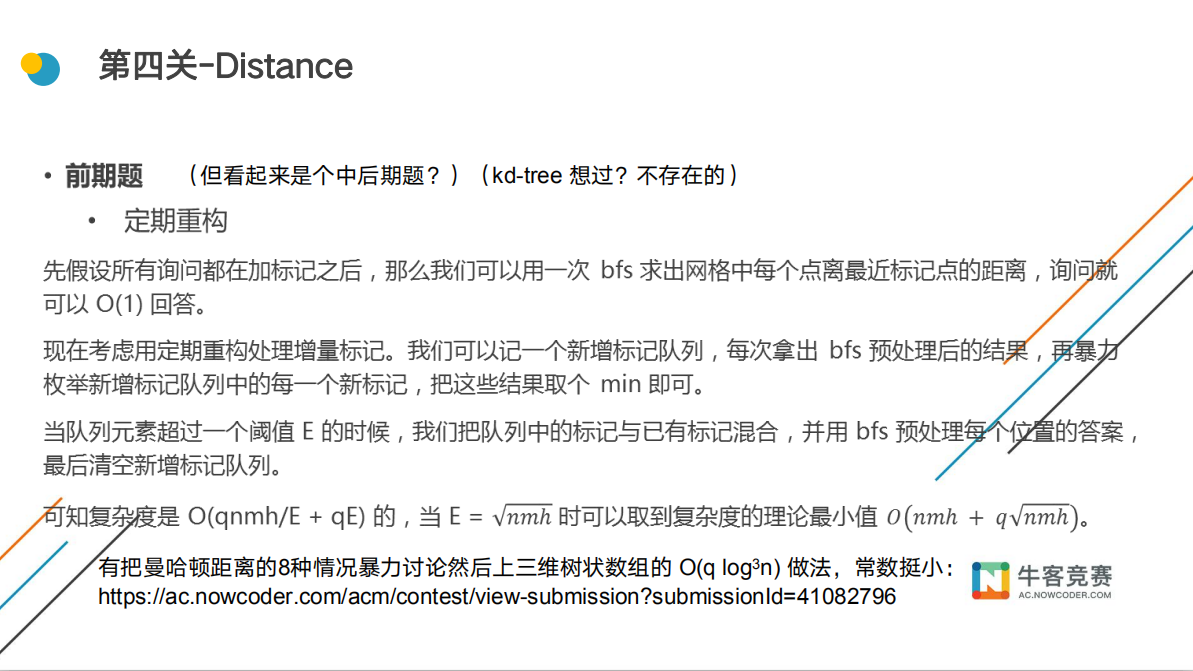@
题意:
在三维空间((n imes m imes hle 100000))内,有(q(qle 100000))次操作。操作(1):添加一个点进入空间;操作(2):查询最近点对。
分析:
比赛时听G黄说完题意感觉看似好像裸题,一道在二维平面上操作完全的题:BZOJ2716
那么KD-Tree还是四维偏序问题呢?(原来都不是。。出题人放出豪言:KD-Tree想过?不可能的
解法1:三维BIT - 862ms
- 把曼哈顿距离的绝对值去掉后,共有8种情况。
- 用8个BIT把每个点拆掉绝对值后的8种贡献记录一下即可。
- 比如这种情况:这个点在其他点的左后下方时:(len=|x1-x2|+|y1-y2|+|z1-z2|=(x1+y1+z1)-(x2+y2+z2))。就(update(x2,y2,z2)),值为(-(x2+y2+z2))。以此类推。
- 我们知道对于两个确定的点,他们相对位置也确定了,显然(p2)在用(p1)的正确相对位置的(query())求出来的距离一定是最小的。这种做法正确性十分显然。然后BIT常数非常小,很容易过去的。
解法2:定期重构+BFS - 86ms (ps:好像是最快的
定期重构这应该是一个很常见的套路的吧?有些分块好像经常有这种操作?

- 对三维空间维护一个值(dis[i]),表示离当前点(i)位置的最近点距离。
- 当新加入的点的数量小于阈值MX时,暴力比对这些新加入的点。
- 当达到了阈值MX时,就用这些新加入的点松弛我们的(dis[])即可。
- 代码挺好懂的。。。
Code1
const int MXN = 3e3 + 7;
const int MXE = 2e6 + 7;
typedef vector<int> VI;
typedef vector<VI > VVI;
typedef vector<VVI > VVVI;
//mat c(a.size(), vec(b[0].size(), 0));
//VVVI bit(n+1,VVI(m+1, VI(h+1, INF)));
int n, m, h, q;
struct BIT {
int n, m, h;
vector<vector<vector<int> > > bit;
void init(int _n, int _m, int _h) {
n = _n, m = _m, h = _h;
bit = VVVI(n+1,VVI(m+1, VI(h+1, INF)));
}
void update(int _x, int _y, int _z, int v) {
for(int x = _x; x <= n; x += lowbit(x)) {
for(int y = _y; y <= m; y += lowbit(y)) {
for(int z = _z; z <= h; z += lowbit(z)) {
bit[x][y][z] = sml(bit[x][y][z], v);
}
}
}
}
int query(int _x, int _y, int _z) {
int res = INF;
for(int x = _x; x > 0; x -= lowbit(x)) {
for(int y = _y; y > 0; y -= lowbit(y)) {
for(int z = _z; z > 0; z -= lowbit(z)) {
res = sml(bit[x][y][z], res);
}
}
}
return res;
}
}bit[8];
int main() {
#ifndef ONLINE_JUDGE
freopen("/home/cwolf9/CLionProjects/ccc/in.txt", "r", stdin);
// freopen("/home/cwolf9/CLionProjects/ccc/out.txt", "w", stdout);
#endif
n = read(), m = read(), h = read(), q = read();
int opt, x, y, z, ans;
for(int i = 0; i < 8; ++i) bit[i].init(n, m, h);
while(q --) {
opt = read(), x = read(), y = read(), z = read();
if(opt == 1) {
for(int i = 0; i < 8; ++i) {
int v = (i&1?x:-x) + ((i>>1)&1?y:-y) + ((i>>2)&1?z:-z);
// debug(i, i&1?x:n+1-x, (i>>1)&1?y:m+1-y, (i>>2)&1?z:h+1-z, v)
// debug(i&1?n+1-x:x, (i>>1)&1?m+1-y:y, (i>>2)&1?h+1-z:z)
bit[i].update(i&1?n+1-x:x, (i>>1)&1?m+1-y:y, (i>>2)&1?h+1-z:z, v);
}
}else {
ans = INF;
for(int i = 0; i < 8; ++i) {
int v = (i&1?-x:x) + ((i>>1)&1?-y:y) + ((i>>2)&1?-z:z);
// debug(x, y, z)
// debug(opt, i&1?n+1-x:x, (i>>1)&1?m+1-y:y, (i>>2)&1?h+1-z:z)
ans = sml(ans, v + bit[i].query(i&1?n+1-x:x, (i>>1)&1?m+1-y:y, (i>>2)&1?h+1-z:z));
}
printf("%d
", ans);
}
}
return 0;
}
Code2
const int MXN = 1e6 + 7;
const int MXE = 2e6 + 7;
typedef vector<int> VI;
typedef vector<VI > VVI;
typedef vector<VVI > VVVI;
//mat c(a.size(), vec(b[0].size(), 0));
int n, m, h, q;
const int MX = 1000;
VI X, Y, Z;
int dis[MXN];
namespace lh {
int hash(int x, int y, int z) {
return x * m * h + y * h + z;
}
}
struct lp {
int x, y, z;
};
int dir[6][3] = {1,0,0,-1,0,0,0,1,0,0,-1,0,0,0,1,0,0,-1};
void rebuild() {
queue<lp> Q;
for(int i = 0; i < SZ(X); ++i) {
dis[lh::hash(X[i], Y[i], Z[i])] = 0;
Q.push({X[i], Y[i], Z[i]});
}
while(!Q.empty()) {
lp A = Q.front(); Q.pop();
for(int i = 0; i < 6; ++i) {
int px = A.x + dir[i][0], py = A.y + dir[i][1], pz = A.z + dir[i][2];
if(px < 0 || py < 0 || pz < 0 || px >= n || py >= m || pz >= h || dis[lh::hash(px, py, pz)] <= dis[lh::hash(A.x, A.y, A.z)] + 1) continue;
dis[lh::hash(px, py, pz)] = dis[lh::hash(A.x, A.y, A.z)] + 1;
Q.push(lp{px, py, pz});
}
}
X.clear(), Y.clear(), Z.clear();
}
int main() {
#ifndef ONLINE_JUDGE
freopen("/home/cwolf9/CLionProjects/ccc/in.txt", "r", stdin);
// freopen("/home/cwolf9/CLionProjects/ccc/out.txt", "w", stdout);
#endif
n = read(), m = read(), h = read(), q = read();
int opt, x, y, z, ans;
clr(dis, 0x3f);
while(q --) {
opt = read(), x = read(), y = read(), z = read();
-- x, -- y, -- z;
if(opt == 1) {
X.eb(x), Y.eb(y), Z.eb(z);
}else {
ans = dis[lh::hash(x, y, z)];
for(int i = 0; i < SZ(X); ++i) ans = sml(ans, abs(x - X[i]) + abs(y - Y[i]) + abs(z - Z[i]));
printf("%d
", ans);
}
if(1 || SZ(X) == MX) rebuild();
}
return 0;
}